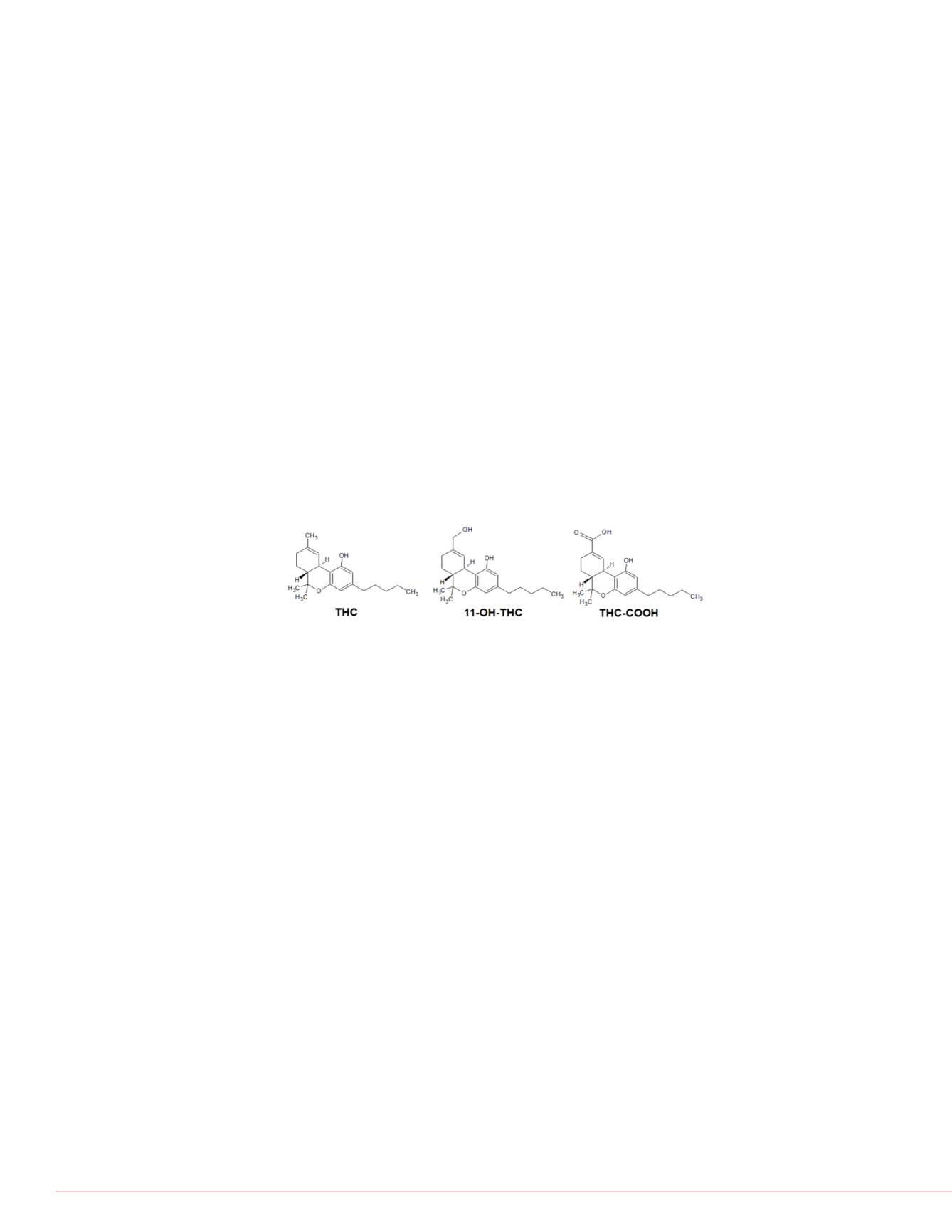

2
Quantitative Analysis of THC and Main Metabolites in Whole Blood Using Tandem Mass Spectrometry and Automated Online Sample Preparation
Christophe Petit, Martine Lachambre Analysis Expertise
Overview
Purpose:
Sensitive quantification of THC, 11-OH-THC and THC-COOH from whole
blood with Thermo Scientific TurboFlow technology. For confirmation purposes,
expected limit of quantification must be close to 0.5 ng/mL
.
Methods:
Blood samples were treated by protein precipitation followed by an online
extraction and analysis by Reverse Phase Liquid Chromatography (RP-LC) coupled
to
mass spectrometry.
Results:
This method was linear from 0.5-100 ng/mL for THC and its metabolites with
good repeatability and sensitivity.
Introduction
Cannabis is the most highly used illicit substance around the world, and due to its
psychoactive effects, it is of great importance to have analytical procedures for the
assessment of the extent of its abuse. The major psychoactive constituent product of
cannabis is
Δ
9
-tetrahydrocannabinol (THC) that is rapidly metabolized mainly in11-
hydroxy-
Δ
9
-tetrahydrocannabinol (11-OH-THC) and then in 11-nor-
Δ
9
-
tetrahydrocannabinol-9-carboxylic acid (THC-COOH), chemical structures are
presented on figure 1.
.
To have a better understanding of the effects of cannabis abuse, blood analysis is
recommended. Nevertheless, THC and 11-OH-THC have short windows of detection in
this matrix, and therefore limits of detection for their analysis are often settled to
concentrations as low as 0.5 ng/mL.
In recent years, LC-MS has gained ground to GC-MS as a reference method for the
analysis and confirmation of drugs of abuse in biological matrices in clinical and forensic
toxicology. In the case of cannabinoids, it is particularly interesting to attain high
sensitivities without a need for derivatization, but one of the key parameters to achieve
sensitivity requirements is the choice of an appropriate sample treatment prior to the
LC-MS method.
Thermo Scientific TurboFlow technology is an automated online sample preparation
technique that has been coupled to LC-MS/MS for the quantitative analysis of biological
samples. Our goal is to develop a method to measure THC and its metabolites by
reducing method time while attaining good analytical performances.
Methods
Sample Preparation
A 0.2
-
mL sample (whole blood) was spiked with internal standards (IS) and then mixed
with 0.4 mL of 0.1% formic acid in acetonitrile (v/v) . The mixture was vortexed and
stored at 0 °C for 10 min. After a 2 minutes sonication, the mixture was centrifuged at
10,000 rpm for 10 min, and 90 μL of supernatant was injected for LC
-MS/MS analysis.
FIGURE 1. Molecular structures of Δ
9
-tetrahydrocannabinol (THC) and main
metabolites,11-hydroxy-Δ9-tetrahydrocannabinol (11-OH-THC) and 11-nor-Δ9-
tetrahydrocannabinol-9-carboxylic acid (THC-COOH).
TurboFlow and LC method
The TurboFlow™ method was
Scientific TurboFlow Cyclone-
Thermo Scientific Accucore C
mobile phases were as follows
formic acid in acetonitrile; loadi
(40/40/20 v/v/v) ; elutingC : 10
elutingD : 0.1% formic acid in
Mass Spectrometry
A Thermo Scientific TSQ Va
operated with a heated elect
ionization mode for THC and
THC-COOH. Data were acq
(Figure 4).
FIGURE 2. . “Focus Mode T
FIGURE 3. TurboFlow and
TurboFlow metho
(Loading
FIGURE 4.
MS source par



















